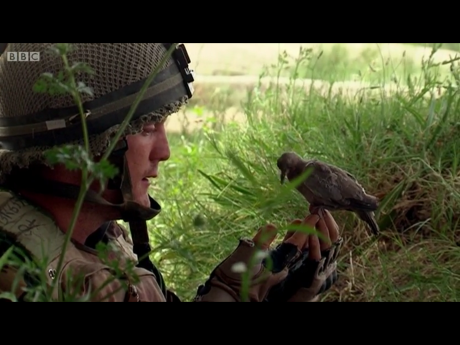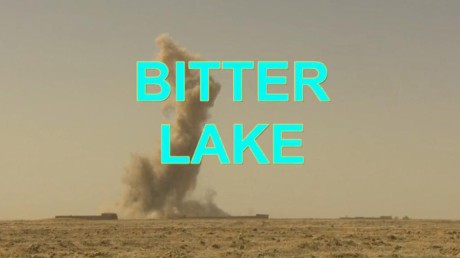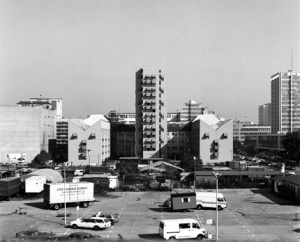There’s a scene in Adam Curtis’ new history-essay, Bitter Lake, which made me turn away — and cry, and wait until the un-narrated scene was finished. It shows a young Afghani girl, maybe aged 6 or 7, sitting by her father. They’re in a hospital. In Afghanistan. Her right eye seems to have been gouged out, her left hand and both her legs are heavily bandaged, twisted. She’s the victim of a bomb. The camera films them face-on. She’s there, placid, damaged, no doubt confused, shattered. But silent. Her father and the unseen health staff are doing their best to elevate the tragic situation. He offers her a flower, a red flower, with a smile, a loving smile, as if this red flower, its intrinsic beauty, might take her and them and maybe even their broken land somewhere else.

After I opened my eyes again, I see a soldier. He’s in a grassy landscape. I’m assuming it’s Afghanistan. That after all is what Bitter Lake is ‘about.’ Close by, a bird. Also just sitting there, minding its avian business. The soldier reaches out to the bird, carefully, delicately — yet the bird doesn’t fly away. In fact, it responds affectionately. They commune. This footage is also un-narrated, a moment of irrational tenderness, perhaps just before another bomb is set off, and other small children will be maimed irrevocably, or that soldier will be killed, and that bird decides to flee Afghanistan.
We listen to the news and we may think we are informed. But footage that makes its way to us is usually there because it can perform shorthanded and spectacularly. But what about everything else? All the time and space between those newsworthy ‘money shots’? For lack of a better phrase, where actual life occurs?
Much has been said about the fact that Curtis has made his new 137 minute film available only on the BBC online iPlayer, so that he can go long-form, free-form. But I’ve always thought of his film-essays as single pieces, 3 or 4 hours long, subsequently sliced into hour long fragments, to fit normal TV schedules.
The difference in Bitter Lake is that the strongest, most affective — and perhaps most informing — sections are these long, uninterrupted sequences where Curtis allows us to see footage from the never-seen BBC Afghanistan archive in a primary, unrhetorical manner. He allows them to ‘speak.’
This is what I’m taking from Bitter Lake.
There seems to be two films encased together. The first is the more familiar Adam Curtis-esque quantum hidden history, how causes (in this case, Saudi Arabia) ricochet to make events and vice versa. But the second film, the one I’m grateful to see and hear, the one that’s made me flinch away and well with tears, is akin to what cameras would tell us if we asked them to tell us everything they saw and heard. Everything. The lilts of nothingness, wordlessness, and the violence that occurs beyond the frame of vision we permit violence to operate in and as. Video game or not. Reality TV or reality free.
At the start of Pierrot le fou, Godard’s 1965 film that makes margins into centres of cities and souls, we hear Ferdinand read from Elie Faure’s History of Art. It’s worth working your way to the end of this longish excerpt, for the very last word:
‘Past the age of fifty Velasquez stopped painting definite things.
He hovered around objects with the air, with twilight,
catching in his shadows and airy backgrounds…
the palpitations of colour…
which formed the invisible core of his silent symphony.
Henceforth, he captured only…
those mysterious interpenetrations of shape and tone that form a constant,
secret progression,
neither betrayed nor interrupted by any jolt or jar.Space reigns supreme.
It is as if an aerial wave, sliding over the surfaces,
soaked up their visible emanations, defined and modeled them,
then spread them about like a perfume,
an echo of themselves,
a scattering of impalpable dust.
The world he lived in was one of sadness:
A degenerate king, sickly infantes,
idiots, dwarfs, cripples,
a handful of clownish freaks dressed up as princes,whose function it was to laugh at themselves…
and to amuse a cast that lived outside the law,
in the meshes of etiquette, plots and lies,
bound by the confessional and remorse,
with the inquisition and silence at the door.”
Listen to this, little girl!
“A spirit of nostalgia pervades his work, yet he avoids what is ugly, sad,
or cruelly morbid about those oppressed children.
Velasquez is the painter of evening,
of open spaces and of silence,even when he painted in broad daylight or in a closed room,
even with the din of battle or of the hunt in his ears.
As they seldom went out during the day,
when everything was drowned in torrid sunshine,
the Spanish painters communed with the evening.”
Beautiful, isn’t it, little girl?’

